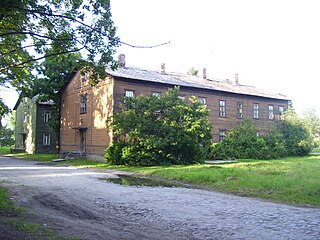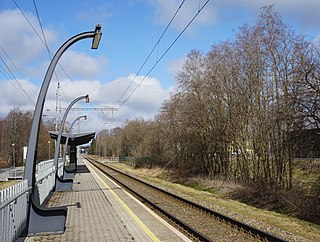
Tallinn is the capital and most populous city of Estonia. Situated on a bay in north Estonia, on the shore of the Gulf of Finland of the Baltic Sea, Tallinn has a population of about 461,000 and administratively lies in the Harju maakond (county). Tallinn is the main governmental, financial, industrial, and cultural centre of Estonia. It is located 187 km (116 mi) northwest of the country's second largest city, Tartu; however, only 80 km (50 mi) south of Helsinki, Finland, also 320 km (200 mi) west of Saint Petersburg, Russia, 300 km (190 mi) north of Riga, Latvia, and 380 km (240 mi) east of Stockholm, Sweden. From the 13th century until the first half of the 20th century, Tallinn was known in most of the world by variants of its other historical name Reval.

Tallinn Airport is the largest international airport in Estonia. The airport is also officially called Lennart Meri Tallinn Airport after the former president of Estonia Lennart Meri.

Meistriliiga, officially known as A. Le Coq Premium Liiga for sponsorship reasons, and commonly known as the Premium Liiga, is the highest division of the Estonian Football Association annual football championship. The league was founded in 1992, and was initially semi-professional with amateur clubs allowed to compete. With the help of solidarity mechanisms, the league is fully professional since the 2020 season.

Tallinna Linnatranspordi AS (TLT) is a transportation company owned by the city of Tallinn, Estonia. TLT is a result of the merger of Tallinn Bus Company and Tallinn Tram and Trolleybus Company in July 2012. The company provides bus, trolleybus, and tram services in Tallinn.

The Estonian Navy are the unified naval forces among the Estonian Defence Forces.

Kalevi Keskstaadion is a multi-purpose stadium in Tallinn, Estonia. Opened in 1955 and having a capacity of 12,000, it is the traditional venue of the Estonian Dance Festival and the former home ground of JK Tallinna Kalev. The address of the stadium is Staadioni 8, 10132 Tallinn.

Kopli is a subdistrict of the district of Põhja-Tallinn in Tallinn, the capital of Estonia. It is located on the Kopli Peninsula and is bordered by parts of the Tallinn Bay, the Kopli Bay to the southwest and the Paljassaare Bay to the north. Kopli has a population of 7,240. Kopli's former German name until 1918 was Ziegelskoppel.

Lasnamäe is the most populous administrative district of Tallinn, the capital of Estonia. The district's population is about 119,000, the majority of which is Russian-speaking. Local housing is mostly represented by 5–16 stories high panel blocks of flats, built in the 1970–1990s.

Public transport in Tallinn consists of bus, tram, trolleybus, train, and ferry services. Tallinna Linnatranspordi AS mainly operates bus, tram and trolleybus routes, while Elron offers electric train services, and Spinnaker OÜ ferry service to Aegna Island with high speed craft Vegtind. Tram, trolleybus, and bus services were formerly divided between Tallinna Autobussikoondis and TTTK. Still, these companies merged into Tallinna Linnatranspordi AS (TLT) in 2012.Tallinn is the only city in Estonia to have ever used trams or trolleybuses. Elron offers local EMU services to Keila, Paldiski, and Turba in the west and Aegviidu in the east, as well as Viljandi, Tartu, and Narva.

Baltic Station is the main railway station in Tallinn, Estonia, and the largest railway station in Estonia. All local commuter, long-distance and international trains depart from the station.

Maarjamäe is a subdistrict in the district of Pirita, Tallinn, the capital of Estonia. It is bordered by Pirita and Kose to the north, Lasnamäe to the south, Kadriorg to the southwest and the Bay of Tallinn to the west. As of 2022, it has a population of 2,412.
Tomomi Hayashi is a Japanese-Estonian architect.

Tallinn-Tartu-Võru-Luhamaa maantee is a 282-kilometre-long north-southeast national main road in Estonia. The route follows the same path as European route E263. The road forms a major north-south corridor within Estonia, connecting the two largest cities. The highway starts in Tallinn and passes a number of notable towns, namely Kose, Põltsamaa, Tartu and Võru, with arterials branching off towards Paide, Valga, Põlva. The highway ends in Luhamaa intersecting with the T7, heading to either Latvia or Russia.

The Tram System of Tallinn is the only tram system in Estonia. Together with the four-route trolleybus network (et), the four tram lines, with a total length of 19.7 km arranged in a roughly cross-shaped layout, provide a backbone for the public transport network in the Estonian capital. All the routes meet up at Hobujaama stop in the city center. Trams are unidirectional, one-sided and single-person operated, and much of the network runs on segregated two-way track.
OÜ Utilitas is a utility and energy company located in Tallinn, Estonia. It generates thermal energy and electricity and provides district heating services.
Tallinna Kaubamaja Group is Estonian trade concern located in Tallinn. The Group's operators deals with both: retail and wholesale trade. Over one tenth of Estonian retail is contributed by the Group.

Patarei Prison, also known as Patarei Sea Fortress and Tallinn Central Prison, commonly known as The Battery (Patarei), is a building complex in Kalamaja district of Tallinn, Estonia. The premises cover approximately four hectares of a former sea fortress and prison, located on the shore of Tallinn Bay.

Laagri railway station is a station in the Nõmme district of Tallinn, Estonia. The railway station serves the Laagri sub-district of Nõmme and Laagri borough of Saue parish which in combination has approximately 6400 residents.















